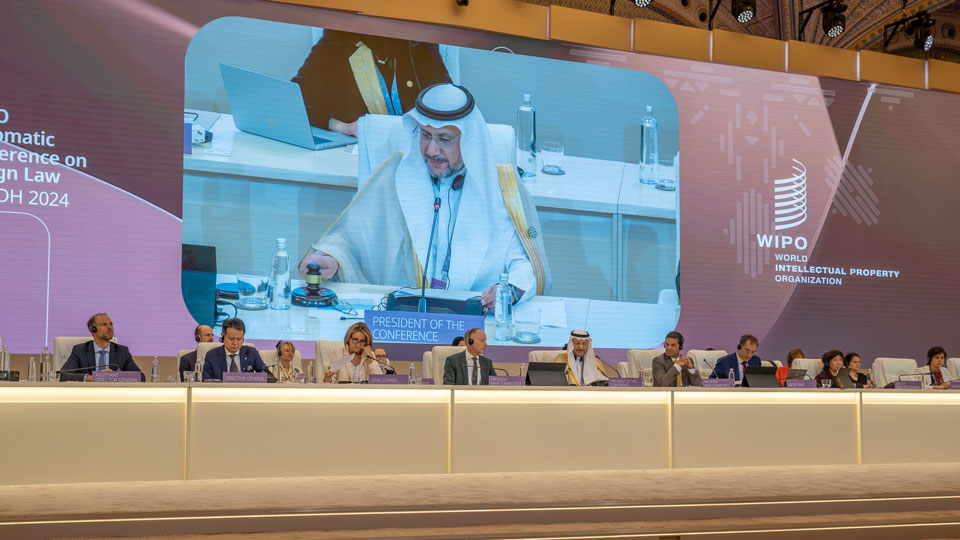WIPO member states today approved a new Treaty that will make it easier, faster and more affordable for designers the world over to protect their designs both at home and abroad, marking a major step forward in empowering designers and fostering international collaboration in design.
WIPO Director General Daren Tang welcomed the adoption of the Riyadh Design Law Treaty – so called in recognition of the city that hosted the final stage negotiations – congratulated negotiators on reaching agreement and praised the leadership of Conference President, Dr. Abdulaziz AlSwailem, CEO of the Saudi Authority for Intellectual Property (SAIP).

“After 20 years, and two long weeks – we made history today, and we welcome the 28th WIPO Treaty – the Riyadh Design Law Treaty,” Mr. Tang said.
Speaking at the end of the diplomatic conference that was hosted by Saudi Arabia at the King Abdul Aziz International Conference Center in Riyadh from November 11-22, 2024, Mr. Tang said the Treaty – the second adopted by member states in the same year – is not only a victory for designers but a boon for multilateralism.
“In May, we came together to deliver the WIPO Treaty on IP, Genetic Resources and Associated Traditional Knowledge. Six months later, we came together again to deliver the Riyadh Design Law Treaty. We have demonstrated that multilateralism can change the world for the better,” Mr. Tang said.
Mr. Tang emphasized the importance of the new pact for designers, noting: “The process of negotiations allowed us to really engage on a topic which WIPO had not put at the center of our work for some time – that of designs and designers and the gift they have in using color, form, shape, beauty and aesthetics to delight our senses, enrich our lives, promote our heritage and transform our culture.”
“Let this conference inspire us to a world where innovation knows no borders, where creativity flourishes and where IP serves as a powerful force for good. Together, we’ve made history. Together, let us continue to do so for the good of innovators and creators everywhere,” Mr. Tang concluded.
Dr. AlSwailem said “The name ‘Riyadh Design Law Treaty’ reflects Saudi Arabia’s pivotal role as a bridge between cultures and a hub for supporting global initiatives. Adopting this Treaty is a historic achievement highlighting Saudi Arabia’s cooperation and contribution to the international intellectual property framework. It opens new avenues for collaboration among member states. This Treaty will lay the foundation for vital legal frameworks that benefit designers and bolster innovation and creativity worldwide.”
Benefits of the Riyadh Design Law Treaty
Designs drive consumer choices by making products attractive to consumers. They are business assets that increase a product’s market value and provide a competitive advantage. The Riyadh Treaty will make it significantly easier for designers, especially smaller scale designers and micro, small and medium-sized enterprises (SMEs), to register their work.
Today, the process for protecting designs varies from one country to another. In some countries, designs are filed as “registered designs.” Registration systems may involve the examination of design applications by the IP office, involving procedures that vary from country to country. In other jurisdictions, designs are protected under patent law as “design patents,” which are usually only granted after a thorough examination of the design application by the IP office.
In addition, designers generally must follow the filing procedures set by the IP office of the country in which they are seeking protection. Because design rights are territorial and thus limited to the country or region in which protection was obtained, designers must go through the same process in each country or region where they wish to protect their designs.
The Riyadh Treaty will help to make the framework for design protection procedures more predictable and make the procedures themselves less complex and more affordable. It will be easier for designers to file applications in several different jurisdictions.
What the Treaty will do:
·set a maximum list of indications or elements that designers must submit with an application. Establishing a closed list of elements will help to create a predictable framework for design protection procedures: designers wishing to file an application will know exactly what indications or elements may be required.
·allow applicants to choose how they represent the design in an application (drawings, photographs or, if admitted by the IP office, video).
·allow applicants to include several designs in a single application, under certain conditions.
·set out requirements for the granting of a filing date. Keeping the list of filing-date requirements for design applications to a minimum is crucial because, in the field of design, postponing the filing date can result in a definitive loss of rights.
·provide for a grace period of 12 months following a first disclosure of the design, during which such disclosure will not affect its validity for registration.
allow applicants to keep their designs unpublished for at least six months after having secured a filing date.
·provide relief measures and offer some flexibility to applicants to prevent them from losing their rights if they miss a deadline. Without such measures, missing a time limit generally results in a loss of rights. In the case of designs, that loss is irreparable.
·simplify the procedure for requesting the renewal of a design registration.
·furthers the introduction of e-filing systems for designs and the electronic exchange of priority documents.
The Treaty foresees the availability of technical assistance to developing and least developed countries for the implementation of the Treaty.
Moreover, the Riyadh Design Law Treaty expressly interfaces design protection with the protection of traditional knowledge and traditional cultural expressions. This is achieved through a provision under which contracting parties may require applicants to file information on traditional cultural expressions and traditional knowledge relevant to the eligibility for registration of the design.
The Treaty requires 15 contracting parties to enter into force.
Comment